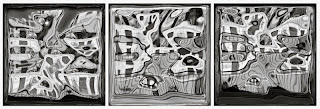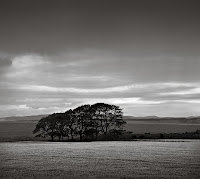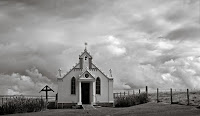
In a certain Chinese encyclopedia called the
Heavenly Emporium of Benevolent Knowledge - perhaps imagined, perhaps real -
Jorge Luis Borges writes that "...animals are divided into (a) those that belong to the emperor; (b) embalmed ones; (c) those that are trained; (d) suckling pigs; (e) mermaids; (f) fabulous ones; (g) stray dogs; (h) those that are included in this classification; (i) those that tremble as if they were mad; (j) innumerable ones; (k) those drawn with a very fine camel's-hair brush; (l) etcetera; (m) those that have just broken the flower vase; (n) those that at a distance resemble flies."
The list is both absurd and profound. It is absurd - or so we think at first glance - because it excludes so many "categories" we (the readers) likely take for granted. Where are the "things that are shaped like spheres or boxes"? Where are the "things that are red"? Where are the things that "make us smile"? (Of course, perhaps these "obvious" categories, and others like them, might also strike you - kind reader - as being equally inept at containing reality).
The list is also profound (though we may come to appreciate it as being so only upon careful reflection) because it reminds us that all categories, however a priori "obvious" and intuitive - are arbitrary, except for the meaning they possess to us as individual observers (and even then, only in the brief instant during which our minds muse on the transient patterns percolating in what the world presents to our senses).

“The division of the perceived universe into parts and wholes is convenient and may be necessary, but no necessity determines how it shall be done.” — Gregory Bateson (1904 - 1980)
The subject of categories, partitions, and patterns has recently come up as I look forward to the opening reception of a three-artist exhibit entitled
Worlds Within Worlds at the
American Center for Physics (One Physics Ellipse, College Park, MD, 20740). The reception will be held monday, November 16, 2009, between 5:30 - 7:30, with a gallery talk and short presentations scheduled for 6:00pm.
"The painting rises from the brushstrokes as a poem rises from the words. The meaning comes later." -
Joan Miro (1893 - 1983)

As I wrote in an earlier blog entry, this exhibit consists of hand-picked works by all three artists (a sculptor, a traditional artist, and yours truly - ostensibly a "photographer") that are all someway related to science;
physics in particular. All three artists were selected (by curator
Sarah Tanguy) with an eye toward either the artist or his/her work having some connection to physics. In the case of
Julian Voss-Andreae, who is both a physicist and artist/sculptor by training, both his background and art are obviously appropriate for the exhibit. He is not only a card-carrying physicist (having earned a Masters degree at the University of Edinburgh), but creates works that are directly inspired by the principles and laws of physics. The artist
Cynthia Padgett, while not a scientist by training, has works on display that are also inspired by science; in her case via the exposure she has to astronomy and astronomic images through her son's study of physics.

But what of my own oeuvre, both the small cross-section on display at this exhibit, and my still growing body of work as a photographer? Yes, I too am a card-carrying physicst (having earned my Ph.D. at the University of Stony Brook, NY in 1988). But, unlike
Julian Voss-Andreae, my work rarely has any direct connection to physics. To be sure, many - perhaps all (?) - of my works on display may be interpreted in the context of my being a physicist: my "Entropic Melody" series, for example, is clearly labeled by a term - "
entropy" - used by physicists to denote disorder; similarly, the title of my "Whirls, Whorls, and Tendrils" series is an homage to terms often used in the study of nonlinear dynamical systems to describe certain self-organized patterns. Being a physicist, I cannot help but "see the world as a physicist"; though I honestly do not know what that means other than "seeing the world as a physicist." And my pictures are the best - and
only - evidence of what "seeing the world as a physicist" really means.
What of the works themselves (sans titles)? They are, after all, simply pictures of things: windows, rocks, water, flame, ice, etc. Consider a single image (not a part of the exhibit, but a part of "Entropic Melodies"):

Objectively speaking, this "abstract" is nothing but a shot of a window (you can see the latch at bottom center), where a small pane of glass remains in the lower left corner, a torn piece of fabric adorns the upper right, and the "foreground" is really the corrugated sheet-metal pattern of a building about 30 feet away from where I am standing inside an old barn. What does this have to do with physics? Nothing, and everything (though one would be hard-pressed to explain why either response is appropriate without knowing a bit more about who I am, as a human being, and my body of work, both as a photographer and as a physicist.) I took this picture for a reason, but one which I can neither articulate to others (any better than simply showing them the picture), nor fully understand myself (on a conscious level). It is as though the picture is but one "word" of an unknown language, expressed in some foggy half-formed grammar (parts of which may be of my own choosing and/or creation, and parts of which are wholly alien to me). Paraphrasing an old cliche, it is as though the act of capturing an image pushes me one step closer to understanding why I bother capturing images at all. And how this process unfolds, from picture to picture, is as much a function of "who I am as an artist" as it is of the "parts of the world" I decide to focus my - and my camera's - attention on.
"Physical concepts are free creations of the human mind, and are not, however it may seem, uniquely determined by the external world." - Albert Einstein
Of course, anyone could have taken this picture, were they standing on this spot, and if they had a more or less similar set of aesthetic predilections to mine (independent of how those predilections may have come to be: physicists may be drawn, as I, to the entropic "feel" of the window; artists to the simplicity of the uncluttered composition; and farmers to an unconventional view of a place they spend much of their time immersed in an otherwise very conventional way. The same is true, I would argue, of any other single image. Anyone can, and has, taken more or less the same picture of a tree, or a leaf, or a waterfall, or a dog, ...

But where things start getting interesting is when we focus our attention on a larger body of work, beyond just a few images of this and that. To be sure, individual images in any larger body of work will always still be just that, individual images (the tree, the leaf, the waterfall, and so on). But a body of work tells a deeper, richer story; indeed it tells multiple, and multiply interwoven, stories. A body of work simultaneously serves as diary (of places, events, and aesthetic predilections, among other things), as narrative (explaining how one set of "places, events,..." evolves into others), and - most importantly - as an evolving database of categories that provide an amorphous glimpse of a photographer's self-organized patterns of selection.
"A man sets out to draw the world. As the years go by, he peoples a space with images of provinces, kingdoms, mountains, bays, ships, islands, fishes, rooms, instruments, stars, horses, and individuals. A short time before he dies, he discovers that the patient labyrinth of lines traces the lineaments of his own face." - Jorge Luis Borges, Afterword to El hacedor, 1960

The more extensive the body of work, the deeper an artist immerses herself into the theme (or themes) that define it, and the more "sincere" (i.e., ego-less) the attention the artist gives to its creation, the more indistinguishable the artist's soul becomes from her work; and more meaningful become the aesthetic patterns and categories that otherwise, more typically, lie dormant, in latent form, waiting to be discovered by some discerning eye (not, necessarily, that of the artist!). In the purest sense - as Borges reminds us in one of my all-time favorite quotes from him above - we are what we devote our attention and lives to. For an artist, this can only be described - at least, by someone other than the artist herself (whose only way of "understanding herself" must come from
doing and not reflecting on what she has done) - by the body of life's work produced by the artist. Every photographer, from Fox Talbot to an as-yet unknown "latter-day Ansel Adams" (that may born sometime, somewhere, tomorrow) has taken a picture of a "tree." But the pictures of trees that belong to Fox Talbot's body of work as a photographer are, and cannot be anything other than, uniquely his; as are the trees captured by Henri Cartier-Bresson, Galen Rowell, or scores of other famous and "unknown" photographers. We all weave an invisible, fantastically complicated trail of images in a vast multidimensional aesthetic landscape. While short trails can be expected to overlap with many other trails, both long and short, and are unable to define a unique presence - the longer the trail (i.e., the richer the body of work), and, more importantly, the more sincere the effort of the artist as she forges it - the less important becomes the distinction between the artist and the patterns and aesthetic categories of the body of work the artist has produced. In the end, they are one and the same.
"To create one's own world in any of the arts takes courage." -
Georgia O'keefe

So, what patterns and categories of my work, as a physicist / photographer, are on display at the
"World Within Worlds" exhibit at the
American Center for Physics in College Park, MD? What qualities are inherent in these images that reflect my training as a physicist? What "excursions" do they represent on the trail I'm still in the process of forging in some multidimensional aesthetic space? All I can say for sure, is the images displayed at this exhibit represent what one particular physicist - who happens to also be a photographer - has focused his eye/I on during a short, two-year thick "slice" of time in his life; a very small slice indeed! There are 18 pictures in all, 3 each in 6 "arbitrary" categories. Hardly a sampling that qualifies as even the tiniest of tiny points in my "aesthetic landscape." Could others have created the same set of images? Other photographers, not trained in physics? To an extent, of course, though all would also probably be "different" in ways both meaningful and not. Truthfully, it is as much of a mystery to me what any of these images say or do not say about "how I understand the world" and/or "how I understand myself" as it must surely be to those viewing my work for the first time. But somewhere, embedded within the microscopic strands of an invisible aesthetic fabric, are clues to the self-organized patterns and categories that will, in time, inevitably define the soul that is still weaving them together.
"I would like my pictures to look as if a human being had passed between them, like a snail leaving its trail of the human presence... as a snail leaves its slime." -
Francis Bacon (1909 - 1992)
 Postscript #1:
Postscript #1: There is an interesting new book called
Photography in 100 Words. It is a sampling of 50 photographers' works, along with a short
four word summary of their "style." The author carefully selects four words that - in his opinion - best describe a given artist's oeuvre, viewed as a gestalt. The words are selected from a "master list" of 100 words (that are provided at the end of the book). The book may therefore be viewed as a zeroth-order approximation (as physicists like to say;-) of self-organized meta-patterns in a multidimensional aesthetic space. It would be an interesting thought-experiment to apply this "four word" distillation to one's own body of work; and compare it to how others perceive what we've created. (I did a similar thing in one of my self-published books -
Sudden Stillness - using 10 words, out of a total of 100, to describe each of the images in the book.)
Postscript #2: The "information field" at the top of this blog - where keywords provide links to associated blog entries, and the size of the font of a given keyword denotes the number of entries that are associated with it - is also a crude form of visualizing the emerging aesthetic space.

 ...instead, the photographer begins losing herself in her pictures, thus freeing the pictures to discover their - and her - path. (Instances of a given) tree grow into trees, of different kinds, in different light, at different times - of year and of the photographer's own inner state. The growing set of images evolves to encompass other, related aspects, of the shifting reality the photographer - partly consciously and partly unconsciously -immerses herself in. Perhaps rocks appear, perhaps water, then fog, then leaves, and - later - by an emergence of entirely new "nonphysical" categories - like abstraction, or tao; perhaps the photographer finds herself experimenting with color, or doing away with categories altogether.
...instead, the photographer begins losing herself in her pictures, thus freeing the pictures to discover their - and her - path. (Instances of a given) tree grow into trees, of different kinds, in different light, at different times - of year and of the photographer's own inner state. The growing set of images evolves to encompass other, related aspects, of the shifting reality the photographer - partly consciously and partly unconsciously -immerses herself in. Perhaps rocks appear, perhaps water, then fog, then leaves, and - later - by an emergence of entirely new "nonphysical" categories - like abstraction, or tao; perhaps the photographer finds herself experimenting with color, or doing away with categories altogether.














































